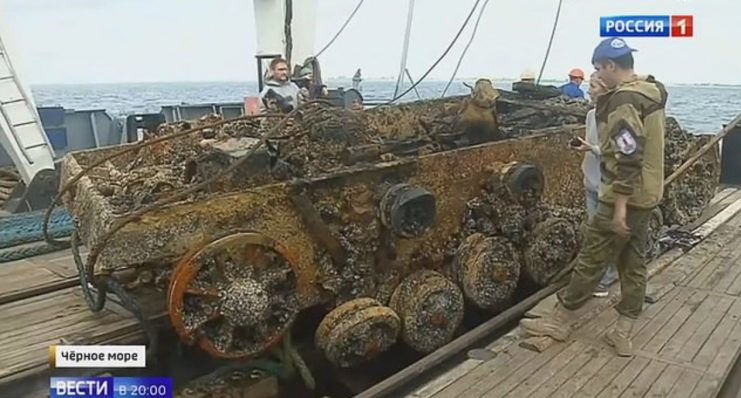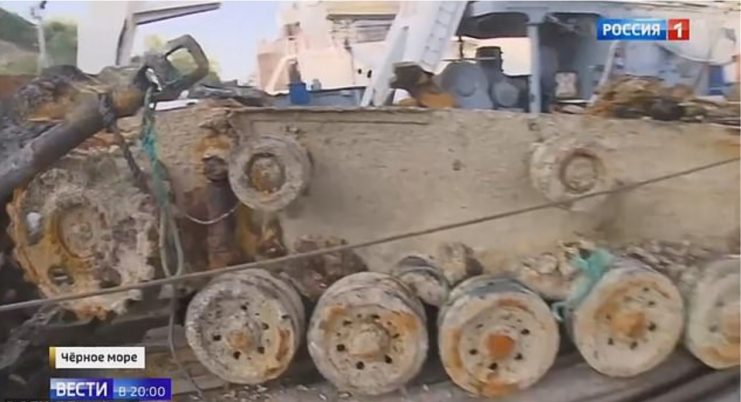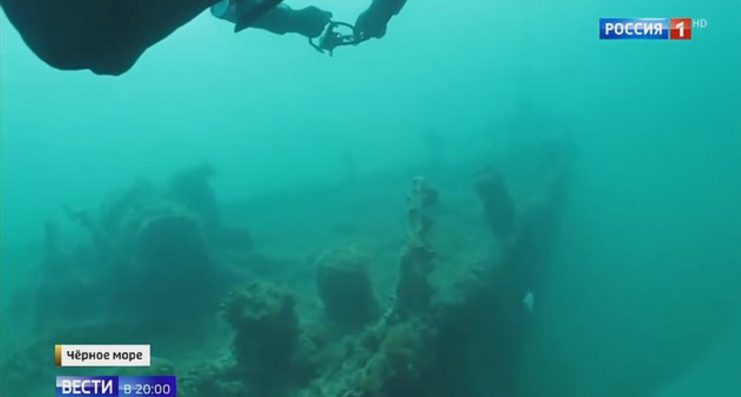There are more Stug IIIs down there. A dangerous underwater mission to clear unexploded ordnance from the seabed and preserve an historical military heritage site has made it possible for a German ‘tank-buster’ Stug III to be brought up from the seabed 77 years after being lost to the waves.
In October 1939 the Santa Fe was taken and captured by the French Navy, renamed the St Andre and sailed under the French flag until 1942 when the Nazis brought her back under German control.
She was repurposed and given back her original name and flag before being dispatched by the German Navy to the Black Sea.

On November 25th the Santa Fe was travelling in convoy from the port of Constantsa, Romania heading for the port of Sevastopol in the Crimea.
She was being escorted by the Q-ship Lola and the minelayer Admiral Murgescu, and minesweepers R-165, R-197 and R-209.
Early that morning an explosion was heard somewhere near the front of the ship and cargo in the fore-hold caught fire.
It quickly spread and shortly after a second explosion occurred which split the vessel in two. Minutes later the Santa Fe and her cargo were on the bottom of the Black Sea.
Twenty-eight crew members were killed and sixteen reported missing.

Surviving contemporary reports remain unclear with regard to the cause of the original explosion with historians divided as to whether a mine could have been the cause, or if there was an accident below decks caused perhaps by poor storage conditions.
On board she was carrying twelve StuG III assault guns, two Jagdpanzer tank destroyers and more then twelve-hundred tonnes of ammunition, including shells, air bombs and barrels of fuel.
The remaining munitions have laid undisturbed in the Kalamitsky Bay off the coast of Crimea for 76 years and have recently been surveyed by the Russian Black Sea Fleet.

Chief of the Russian Ministry of Defence’s Expedition Centre, Evgeny Binyukov, signed an agreement in 2017 with the underwater research centre of the Russian Geographic Society and Central Naval Museum,
They agreed to the preserve military-historical heritage and to work together on joint projects such as the Santa Fe. Regarding the raising of the StuG III he said of the task that, ‘it turned out to be unexpectedly difficult.’
The operation took three months to plan and recently came to fruition when the remains were finally raised above the waves using steel cables and buoyancy aids.
The ship is now undergoing further exploration by Navy divers who are primarily engaged in detonating the dangerously large amount of unexploded ordnance still remaining in, on and around the wreck.
The Stug’s armour appears to have been well preserved despite being submerged under the Kalamitsky bay for 77 years. Even dashboard fragments remain.
The Russian Geographical Society are set to clean and restore it before it is put on public display in the Central Naval Museum.
Wreckage from the Santa Fe covers more than three-hundred square metres of seabed with pieces of the hull torn apart by the force of the explosion.
A second gun is buried under tons of coal which the Russian dive team are preparing to clear. This second StuG III is expected to be brought to the surface this year.
More than ten thousand StuG IIIs were produced by Nazi Germany throughout World War II to be used as an assault gun to destroy enemy tanks.
It was based on the fearsome Panzer III tank and carried a crew of four. Early models were open topped but quickly became fully enclosed as the design progressed.
The Jagdpanzer, (hunting tank) was used extensively throughout North Africa, the Russian Front and at Normandy during the Allied D-Day assault.
The Spellbinding Wheatcroft Collection, an Update
Lancaster Restoration ‘Just Jane’ Update
At the end of the war abandoned vehicles captured by the Russians were eventually donated to Syria where the regime used them in conflicts up until the 1967 Six-Day-War with Israel.
